Table of Contents
An Introduction
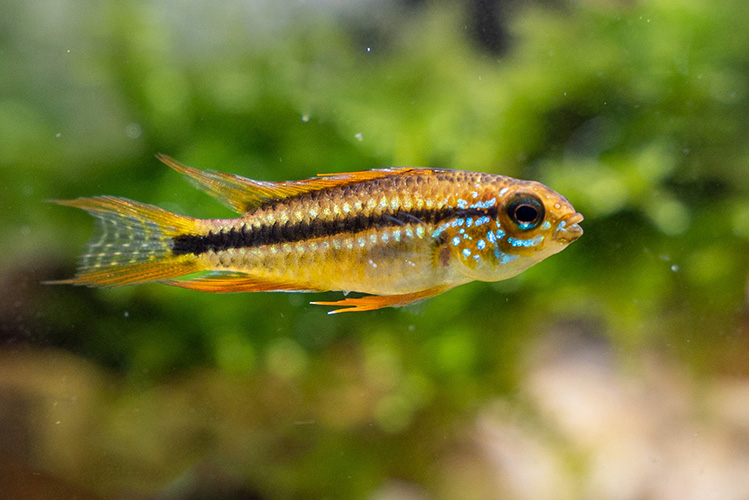
Apistogrammas are enchanting little fish with bold colors and bolder personalities! Nicknamed affectionately as “Apistos”, they are known as being part of the “Dwarf Cichlid” family, a loosely defined term used by fishkeeping hobbyists to describe small-sized fish from the family Cichlidae.
Apistos come in a rainbow of brilliant colors. Equally noticeable is their inquisitive and brazen attitude. You will notice these fish watching everything going on in a room and looking right back at you. This is one of their tell-“tail” personality traits that can be quite intriguing; their curiosity!
There are over 90 kinds of Apistogramma species, with new ones cropping up more and more as scientists explore new waterways. They have a semi-aggressive streak in them but, with adequate space, they can do well with peaceful tankmates. Though, being that Apistrogrammas are smaller, they do not need as much space as the largest South American Cichlids.
If you’re looking for a bright, alert, centerpiece fish for your tank, we think you will like the Apisto! They are quite inquisitive creatures that capture the imagination of aquarists everywhere with their attentive and quirky demeanors. If you are considering adding these fish to your tank, make sure you have some experience under your belt.
They are not recommended for beginners from a management standpoint. They can be a little demanding – and not just regarding territory!
Overview
- Difficulty: Moderate
- Lifespan: 5-10 years
- Size: 3.0-3.5 inches (7-9cm)
- Tank Size: 20 gallons (75 l)
- School Size: Pairs or schools of at least four
- Temperature: 72-86°F (22.2-30°C)
- pH: 6.0-7.0
- Hardness: 2-15 dH
- Ammonia: 0 ppm
- Nitrite: 0 ppm
- Nitrate: < 30 ppm
Checklist
Before the big day comes that you add Apistogrammas to your tank, pause to make sure can confidently check everything off the following list:
- I have the appropriate equipment and set up for the aquarium.
- I have researched all the species going in my tank and my final choices are compatible.
- I am familiar with how to safely transport and release the fish.
- I am capable of the daily, weekly and monthly maintenance the aquarium will require.
- I am prepared to look after this fish properly for the duration of their life.
Size Range
Apistos belong to the group of dwarf cichlids. As such, they grow to an average size of about 3-3.5 inches. Depending on the species, some drop into the nano spectrum, which are 0.8 inches long or less.
Males are usually about double the size of their female counterparts. Depending on the species, they’ll reach about the length of roughly 4 inches (10 cm).
Females grow to about 2 inches (5cm). Size is one of the defining characteristics between the two sexes.
Lifespan
Their lifespan relates to their species, but on average Apistogramma life span is between 5-10 years. You can help them achieve the longer end of that lifespan by maintaining water conditions and giving them a relatively stress-free life.
If an Apistogramma is subject to high-stress levels like improper tank conditions, incompatible tank mates, or unbalanced schools, they will not achieve the high end of that lifespan. Stress leads to illness and even early death.
Behavior
Apistos aren’t as notorious for bullying as others in the Cichlid family (cough cough Jack Dempseys) but they are certainly on the semi-aggressive side. These fish typically set up a territory and love chasing away intruders from their space.
Their aggression tends to spike when they are hungry or spawning. To help avoid any incidents, be sure to keep your Apistogrammas well fed and happy!
Apistogrammas do best in mated pairs or as a school of at least four; one male and 3+ females.This is more likely to lead to a happy community tank. It is advisable to avoid a single male Apistogramma with no “girlfriends” as that is just asking for a bully!
When it comes to people, Apistos are famous for noticing you as soon as you enter the room. Their curiosity keeps them sharp, and you’ll find that they will swim over toward you to check out what you are doing. You can also expect them to clamor at the glass during feeding time. Many fish keepers love Apistos for their lively interaction and the way they seem to recognize you and others in the household.
In The Wild
Apistogramma Cichlids are found in slow-moving waters throughout the tropical region of South America, as well as the Andes and the Brazilian rainforests. In the wild, they are typically spotted in the shallow, sandy-bottomed regions with heavy plant coverage.
Apistos have hardy reputations and can tolerate blackwater conditions. This refers to plant materials breaking down, causing the water to grow dark from the decaying matter.
The Amazon, where you can find many species of Cichlid, has many pockets of blackwater along the way. Sadly, many of these habitats are slowly dissipating because of deforestation. The blackwater habitats these fish prefer are shrinking.
Take the time to research your selected species before bringing your fish home to confirm you aren’t contributing to the shrinking natural population. Only get them from well-trusted sources!
Setting Up an Apistogramma Tank
You can get away with a 20-gallon (75 l) tank for Apistogrammas because they are so small. However, to minimize aggression problems and keep everyone the most comfortable, consider upgrading to a larger size such as a 30-gallon. Some people make the mistake of putting them in smaller tanks because some could be considered “nano fish” but doing so could lead more aggressive fish.
Aim to give your Apistos enough territory for your fish to feel comfortable without excessive amounts of space that overwhelm them. Carefully consider your school size and tank mates.
These fish may be small, but their waste is not! Make sure your tank is set up with a hefty filter such as the Fluval FX4. You want it to be strong but not with so much outflow that it causes them to struggle with swimming around. Consider picking up a quality filter from the Ocean Floor in Phoenix!
Water Conditions
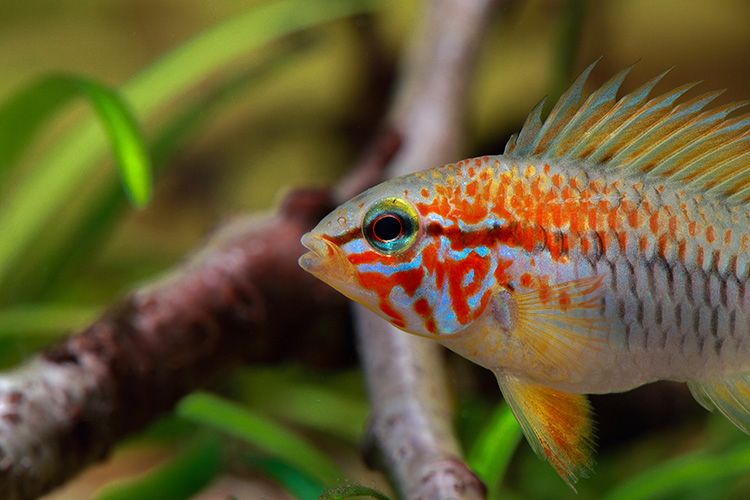
The goal of your tank should be to provide as close to a natural environment as possible and ensure that you are meeting the needs of your species. These fish need soft, slightly acidic water. Do not provide them with hard water, or else your fish will not thrive!
All Apistogrammas come from tropical regions and will tolerate a temperature range between 72-86°F (22-30°C). Apistogramma species in the wild gravitate towards blackwater, the area in which plant debris decays and settles at the sandy bottoms, resulting in soft, slightly acidic waters. You will probably want a pH value between 6.0-7.0, but look into your specific species to see if they have different needs as they can vary dramatically. It’s why you’ll also see water hardness levels ranging from 2-15 dH.
You can always add something like an alder cone or Indian Almond leaves to your tank. As this plant material starts breaking down, it’ll naturally soften the water. It’ll also release tannins into the water. This creates a natural blackwater aquarium for you – mimicking their natural conditions.
Learn about other freshwater fish from Ocean Floor Store here.
Decorating the Apistogramma Tank
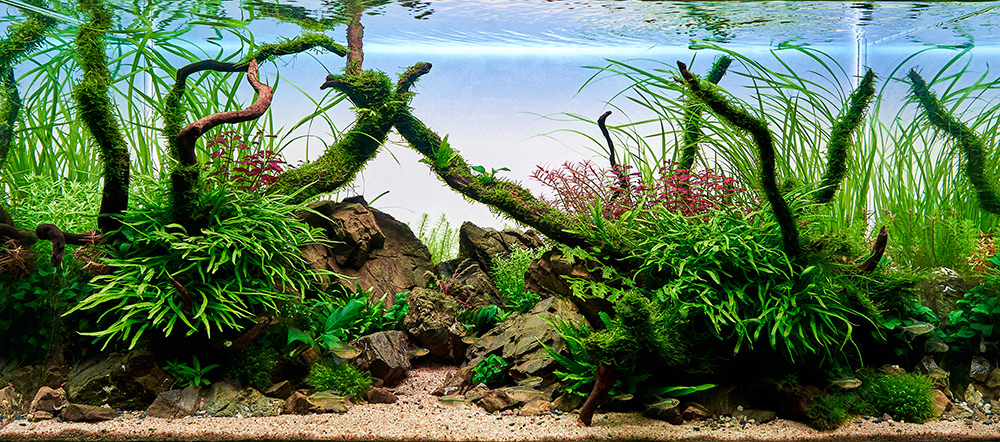
Cichlids love sand! Nothing makes Apistogrammas happier than digging around in their substrate. Choose a fine sand to protect your dwarf cichlids from damage when they are burrowing. Sand in their natural environment tends to be very fine, much finer than construction sand. Apistos enjoy sifting through soft sand that is composed of mostly quartz grains 0.5mm or less.
Having sand in your tank provides the benefit of saving time on landscaping! Leave it to the cichlids and the natural patterns that sand settles itself into. This way the tank retains a nice, organic look with less effort.
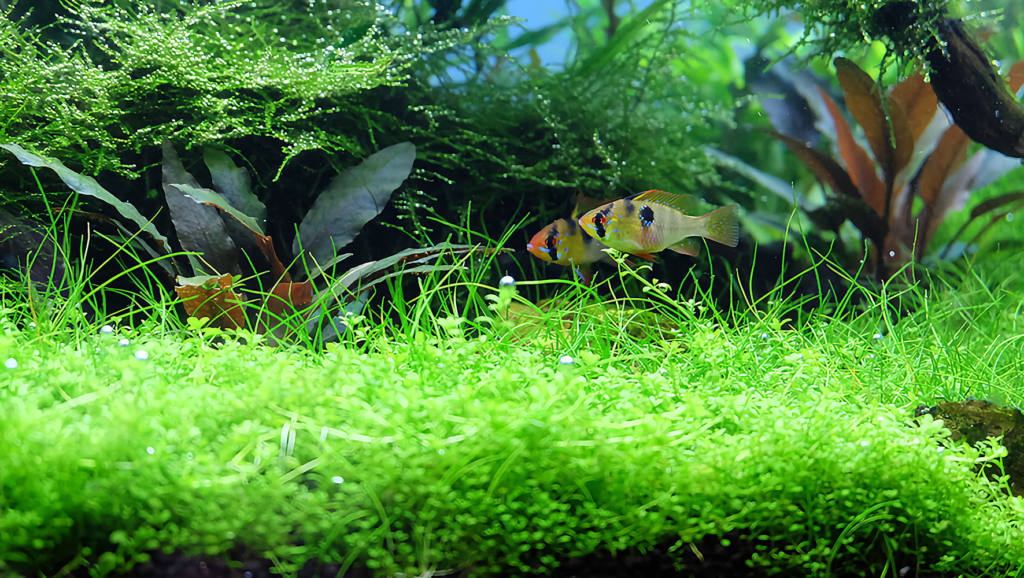
One benefit of going with mosses and/or Java fern is that you will not struggle with keeping the plants anchored in the sandy substrate because mosses don’t need to root into anything. This way you aren’t worried about your wild Apistos accidentally uprooting the plants.
We do know Apistogrammas can be territorial, but they can be bashful too! They do well with hideaways like caves and tubes to retreat when they are nervous.
Another thing to keep in mind when setting up your tank; do not overcrowd the bottom as this is where they prefer to swim!
Apistogrammas in Communities
Apistogrammas are a popular choice in community tanks; they just need adequate space and appropriate schools. They typically occupy the bottom half of the tank, leaving the middle and top of the aquarium, leaving the top and middle section of the aquarium to their tank mates.
Tank Mates
If you put an Apistogramma species in your tank, you will want the remainder of the fish to be peaceful types. They will do well if everyone generally sticks to their territories!
Some ideal tank mates include:
- Bolivian ram
- Bristlenose plecostomus
- Cardinal tetras
- Corydoras
- Tetras
- Otocinclus
- Pencilfish
- Rasboras.
Be cautious about adding other bottom-dwellers (like Loaches, Corydoras or Catfish) to the tank as the Apisto(s) will not like that. There is a good chance they will squabble over the territory unless there is a lot of space for them to be separate.
Incompatible Species
Larger species going in the tank may also overwhelm your Apistogramma. They may be semi-aggressive, but when confronted with larger fish they will back down and seek shelter. This can cause them to stress.
Steer away from fish that are known as fin-nippers. Males have prominent dorsal fins which could be very tempting for those with a fin-nipping habit. Try your best to avoid subjecting an Apisto to this as it can lead to fin rot and stress.
Some famous fin nippers to avoid: Redtail shark, Serpae Tetra, Kissing/Pearl gourami, Tiger barb, Pea puffers, Livebearers, Zebra Danios, and of course, Betta fish.
Diet and Feeding
Apistogrammas are omnivores that lean more on the meat side of the menu. Give them a well-balanced diet with a variety of types of food including meat, greens, live food, and you can use some commercial food as well. Consider investing in some quality homemade fish food recipes to keep them healthy and excited.
As far as commercial fish food goes, make sure you feed them nutritionally dense sinking-style food as the Apistos will NOT swim up to the surface and compete with others. They prefer waiting for the food to come to them at the bottom of the tank.
Live food is always going to be their favorite and they love brine shrimp, glass worms, and larvae. For greens, they will nibble on the plants in the tank and any algae available. A great “healthy snack” for them is cucumbers!
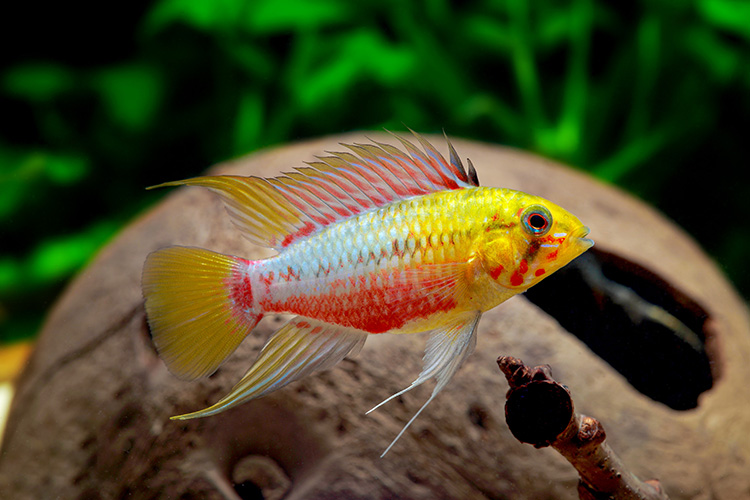
Gender
Apistos differ greatly among males and females. You can tell the difference between them based on the size, shape, and color. Males are larger and have more prominent dorsal fins while the females are less vivid in color. During the spawning season, the females will brighten up their colors so the size difference is a much more reliable indicator.
Breeding: A Variety of Strategies
There are a few strategies when it comes to incubating Apistos and it will depend on the species you are breeding. Some of them mouth-brood, while others prepare and guard their nest. You can look into the method used by your species so you know what to expect.
It’s not too difficult to bred your Apistos in captivity. If you happen to have a bonded pair, they may just do it on their own. If this happens, be mindful of the aggression that may result from the breeding. This aggression could lead to a spike in stress levels amongst the tank, leading to a drop in their immunity.
For this reason, consider taking your time setting up a separate breeding tank if you plan to breed your Apistos.
Parental Responsibility
To ensure a successful spawning season, you should prepare a separate breeding tank for your apistos. This will lower the stress levels for all your fish. A 10 gallon (30 liter) tank will work well for a bonded pair – just don’t leave them there permanently.
Things to do to make your parents as comfortable as possible:
- Set up the tank as you would a normal tank to make them comfortable
- Use a timer on aquarium lights to stimulate a regular day-night schedule
- Cover your filters intake valve with a sponge to protect the fry from getting sucked into it and create a feeling of stagnate water
- Increase the tanks temperature incrementally about 1-2 degrees each day to reach a nice, warm 80°F (26.6°C)
Make sure there are several cave options for your female to choose from. When she is ready, she will coax the male into the cave. She will lay around 80 eggs for him to fertilize. They will both guard the cave from intruders (which should be easy, as no one else should be there).
In about 2-5 days, the eggs hatch. The mother feeds the fry by showing them where the food’s located. You can help by adding some baby brine shrimp to aid in their growth. They reach full maturity at about 4 months.
Health & Disease
Overall, Apistogrammas are known to be healthy fish as long as they are kept in the right conditions. To keep your Apistos happy and healthy, keep them in the right water conditions, free of stress and provide them with a high-quality, dynamic diet.
The biggest issue aquarists face with these fish is struggling with water quality. This is something you will want to establish before you add the fish to your tank.
When fish get stressed, their immunity goes down, leaving them susceptible to ich, parasites and skin issues.
Acquiring Apistogrammas
Apistogrammas have certainly become a popular choice for freshwater fish keepers because of their brilliant colors and unique personalities. However, you should be sure you can handle the demands of keeping them before acquiring an Apistogramma.
The most common colors are typically around $12 a fish. If you are looking for a more dramatic pattern, you could spend upwards of hundreds dollars, especially if they are wild-caught.
Popular Apistogrammas
1. Agassiz’s Dwarf Cichlid (Apistogramma agassizii)
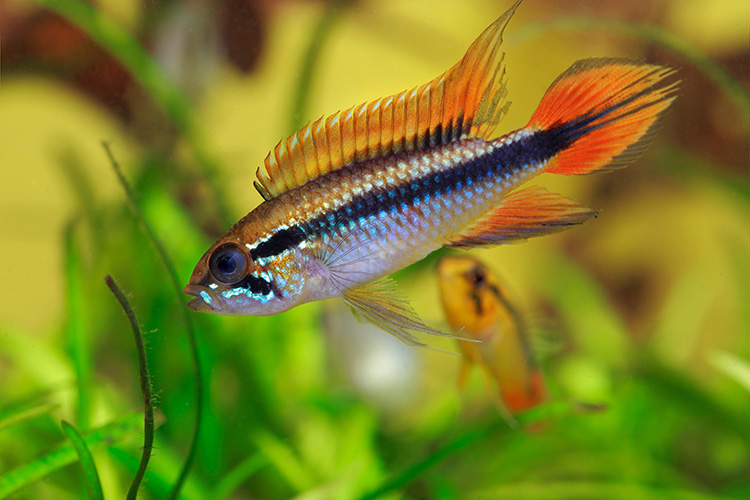
Agassiz’s dwarf cichlids come in a spectrum of color. The gold variety is most popular, with a blue type close behind. They have a more sleek, aerodynamic shape to them compared to some of the others in their family.
These little guys are known to be the most territorial, so don’t make the mistake of putting them in a smaller thank just because they are little. Consider giving them more space to keep them happy.
2. Dwarf Cockatoo Cichlid (Apistogramma cacatuoides)
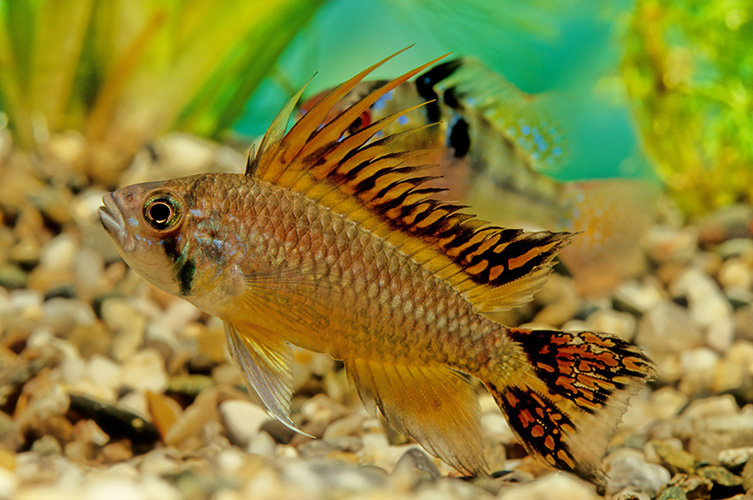
Apistogramma cacatuoides, AKA dwarf cockatoo cichlids, top the list in popularity.
Male cockatoos proudly sport their flaming pattern on dorsal fins that are as tall as the fish is long. This prominent mohawk is where they get their namesake, mimicking the look of the spray of feathers on a Cockatoo bird. These sporty fish have a racing stripe along their side as well, adding to the drama of their look that is so widely admired.
Their fins have a light, feather-like quality that makes them quite tempting for fin-nippers so choose those tankmates carefully!
3. Umbrella Cichlid (Apistogramma borellii)
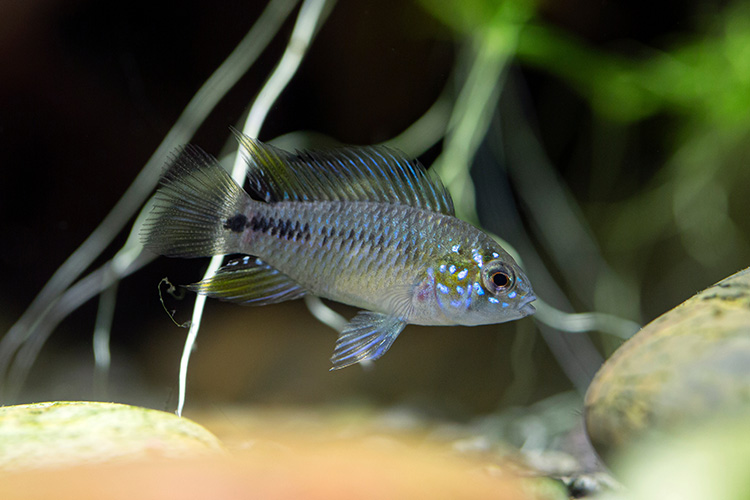
Umbrella cichlids wear a dazzling display of yellow and gold accents with shades of iridescent blues. Their yellow color earns them the nickname of Yellow Cichlid as well, but how could you forget the beautiful blue?!
They are striking little fish that are known to have spots of brilliant blue and red along their head and body. The colors along their body and dorsal fin shine under the tank lights in a way that is sure to catch your eye.
The Umbrella Cichlids are known to be the most gentle of members of the group, making them a solid choice for community tanks.
Dwarf Cichlids
Apistogrammas are famously charming and vibrant colors that entice all who see them! While you need to take extra care when it comes to cichlid care, they make wonderful additions to a community aquarium. Just be sure to set those semi-aggressive creatures for success!
Which species of apisto do you have? How do you manage their aggression? Have you successfully bred them?
Share your questions and stories with us here!

